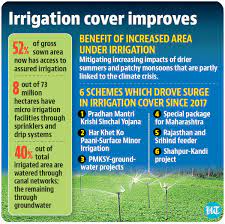52% of cultivated land has irrigation facilities for the first time says NITI Aayog.
For the first time, more than fifty per cent of India’s cultivated land has the certainty of irrigation as a result of an expansion in micro projects says the 2022-23 official data.
From 41% in 2016 to 52% in 2022-23, out of the 141 million hectares of gross sown area, nearly 73 million hectares have irrigation access, says NITI Aayog.
The increase in irrigation cover in dryland areas such as Telangana and Andhra Pradesh will help alleviate the increasing consequences of drier summers and patchy monsoons which are partly linked to the climate crisis.
Agriculture takes about 80% of the country’s water use, which is about 700 billion cubic meters. The June-September monsoons, which is one of the main source of irrigation in the country, still water mostly the kharif or summer-grown crops.

Image source: Hindustan Times
When monsoons are poor, it directly affects the farmers and their income. The ripple effects of this can be seen in the broader economy because rural demand is essential for a country’s economic growth. For example, rural customers account to nearly half of two-wheeler annual sales in the country.
A micro irrigation fund(MIF) with a collection of Rs. 5000 crores was created with the national bank for Agriculture and rural development (NABARD) during 2018-29. Its purpose was to mobilise the state’s resources. Central assistance of Rs. 12,696 crores has been released to states, out of which Rs. 11,845 crores was utilized until last year.
The increase in irrigation was a result of six programmes and projects. Since 2017-18. These include the Har khet ko paani- surface minor irrigation, PMSKY- groundwater project, special package for Maharashtra, Rajasthan and Srihind feeder, and Shahpur Kandi project. Under PMKSY-AIBP, 17 out of 21 irrigation projects have been completed, boosting the state’s irrigation cover by 16%.
Micro-irrigation facilities through sprinklers and drip systems were installed on over 8 million hectares out of the total irrigation expansion area. Data says that 40% of the country’s land is irrigated by canals, while the remaining 60% depends on groundwater which keeps depleting at a rising rate.
An expert at the Watershed India Trust says that the potential of micro-irrigation in the country can be evaluated up to 60 million hectares. Conventional irrigation has 60% efficiency, while drip irrigation can yield up to 90% efficiency.
The jal shakti ministry says that the country has the ability to create irrigation for only 60% of the cultivable land can utilize irrigation facilities, whereas the remaining 40% can’t due to hydrological and geographical reasons.












